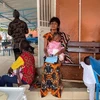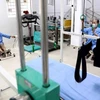 A conference held in HCM City discusses new therapies to increase the survival rate for patients with cancers in the last stage (Photo Courtesy of Buzz Communication)
A conference held in HCM City discusses new therapies to increase the survival rate for patients with cancers in the last stage (Photo Courtesy of Buzz Communication) HCM City (VNA) - The number of cervical cancer cases in Vietnam has fallen by half in the last 30 years thanks to a nationwide network of health facilities providing gynaecology screening, according to Professor Nguyen Chan Hung, Chairman of the Vietnam Cancer Association.
Hung told Vietnam News that gynaecological examinations and tests for the presence of precancerous or cancerous cell on the cervix are available at most health facilities in the country.
In addition, people’s awareness of the need for regular examinations and tests also improves, he said.
“Patients can get more timely treatment to prevent the development of cancer, which has resulted in a drop in cervical cancer,” he said.
Vaccinations, which are given to women under a certain age, have also reduced the incidences of cancer, he added.
According to International Agency for Research on Cancer’s Globocan 2012, a report on incidences, mortality and prevalence of cancers in 184 countries, showed that Vietnam had a lower prevalence of cervical cancer than many other countries, including Cambodia, Myanmar and others in the region.
“People should not be too anxious about this cancer because with early diagnosis and treatment, the rate of recovery is 80-90 percent,” he said.
However, it should not be disregarded, Hung said. Whenever women have excessive vaginal bleeding, they should visit a doctor.
According to a report from Globocan 2012, Vietnam reported 5,146 new cervical cancer cases in 2012.
Speaking at a conference about cervical and ovarian cancers held recently in HCM City, Dr Vu Van Vu, head of medical oncology ward No 1 at HCM City Oncology Hospital, said: “Cervical cancer still is a challenge for the country, and HCM City.”
The cancer is still one of the leading causes of death among women¸ with more than 2,400 dying each year.
In cases of late detection, the five-year survival rate is only 16 percent.
Late last year, the drug bevacizumab, which the Ministry of Health approved to be used in the country, began to be used with chemotherapy. It has helped increase the survival rate for patients in the last stage of cancer.
In 2014, the US Food and Drug Administration approved bevacizumab solution for intravenous infusion in combination with chemotherapy.
At a conference held by the Vietnam Cancer Association in cooperation with HCM City Oncology Hospital and HCM City representative office of Hoffmann-La Roche, Dr. Mary McCormack, consultant Oncologist at London’s University College Hospital, said that doctors should note side effects and have careful patient selection before treatment.
Adverse complications such as wound healing, hypertension and thrombosis can also be avoided by appropriate planning for treatment, she said.
In Vietnam, the drug and chemotherapry combination is used for treatment for patients in the last stage of cancer, including ovarian cancer.
The Globocan 2012 showed that Vietnam had 1,229 new cases with ovarian cancers in 2012. The prevalence of ovarian cancer was the lowest in the region.
However, most cases of cancer are detected in the last stage because ovarian cancer often has similar symptoms to digestive diseases.
Hung said that the cancer could occur at any age, including children. Women should have periodic health check-ups, including abdominal ultrasounds which are one of the ways to detect tumours in ovaries.
Even if tumours are noncancerous, they should be watched by doctors frequently, he said.
“Tumours can reoccur, and become worse,” he added.-VNA






















